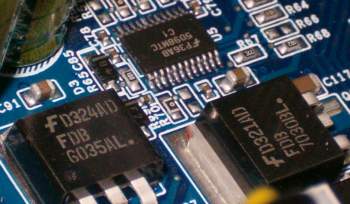Layout


The usual look at layout, top to bottom, left to right. Next to the ATX I/O backplane cluster, we hit the power circuitry for the CPU socket. Fairchild get MOSFET duties, their FDB7030BL and FDB6035AL parts supplying a two-phase delivery system. Another Fairchild part, the 5098MTC IC, controls the voltage supplied. The auxiliary 12V supply socket is in among those components, near the bottom of the cluster. Poor placement for routing of the cable, but I've seen it in worse places.

The socket itself arrives with retention mechanism installed, just incase you get your CPU from an OEM. Albatron keep the same socket orientation as ASUS, west to east as you follow the socket lever. A lone power header sits in between the socket and the memory slots. I'd prefer them all moved one slot over to the right, to leave more room between themselves and the socket area, for users of oversized heatsinks, but they don't violate the socket area as set out by AMD.
Like K8V and KV8-MAX3, slot order preference starts with the slot nearest the CPU. A small gap occupied by the power circuitry for the memory slots lies before the main ATX power connector. IDE ports from the VT8237 sit underneath. I prefer the layout ASUS uses for those ports, but at least the ATX power connector is in a decent position near the edge of the motherboard, minimising impact from that hefty cable, in terms of disrupting CPU heatsink airflow.
The northbridge heatsink is copper coloured aluminium as far as I can tell. If it's real copper, it's a tad shiny for my liking, looking too much like MSI's golden flower cooler material they use on recent GeForceFX 59xx boards. That's coated aluminium, so I'm guessing the Albatron heatsink is too. Not that it's a bad thing, the bridge it cools definitely doesn't seem to get too hot during operation. The fact the sink is passively cooled by case airflow is a testament to that. It's the stand out component on the board at least. There's a fan header on the bottom left edge for a case fan to run from.

That's it for the top half of the board, the AGP slot marks the north-south split as always. The slot itself has one of the cooler retention mechanisms I've seen, a sliding plastic hook that grabs the notch on the card. The good thing about it is the fact it's the length of the slot. So if your fingers can't get at it from one side, try the other, there's usually going to be a gap in there somewhere. A lot less fiddly than recent mechanisms, and a plus point about the layout overall. However, being a six PCI slot design, any card in the AGP slot will more than likely end up fouling the tabs on the end of the memory slots. Graphics card removal is needed if you want to change your memory configuration, sadly. I'd take a five slot design just to avoid that problem. The amount of good on-board hardware means that you wouldn't really miss the loss of potential expansion.
Like K8V, the VT8237 bridge sits high up on the board, next to PCI slots one and two. It's a small ASIC and needs no peripheral cooling. It's been naked like that on probably every board that's used it. No doubt Leadtek will cool it for effect on a special edition board somewhere down the line, but until then, it makes taking pictures of it a lot easier. So easy infact, that I haven't bothered for this article.
Since Albatron don't bother with extra SATA hardware, the board space that it would occupy seems to be taken up with dual 4MBit BIOS chips, one with a natty AWARD sticker, one without. Albatron implement a feature they call BIOS Mirror. Like Gigabyte's DualBIOS, it's a simple backup and restore feature for your BIOS. Should the main BIOS get corrupted, the copy will restore it for you. Pretty neat, a feature that should be present on all boards.
The Envy24PT sits close to the right side of the PCI slots, along with the VT6307 FireWire controller. The VT1616 CODEC chip and the WM8278 DAC are on the far side of the PCI slots, near the left hand board edge. Standard placement for everything.

The 3COM LOM controller sits to the left of the AGP slot, the floppy port is underneath the last PCI slot (what a poor placement, boo) and the SATA ports get an L shaped layout, placed near the battery on the right hand side of the motherboard. Decent placement for them as I like to bleat on about. As close to the right hand board edge as possible please.
The layout is pretty standard, but could definitely be better with a bit more thought, if it is indeed feasible to move things around and have everything still working. I'd like memory slots moved over to the right, five PCI to move the AGP slot away from the memory slots, stacked SATA ports closer to the board edge and the floppy port moved out near the right edge too, away from the last PCI slot.
Otherwise it's not bad. The passive northbridge heatsink is a highlight, the lack of sensible identification of the ATX case headers isn't. I don't like referring to the manual for those, if at all possible.
Click for a picture of the VT1616 CODEC (~17KB)
Click for a picture of the 3Com 3C940 LOM and the AGP retention slider (~43KB)









